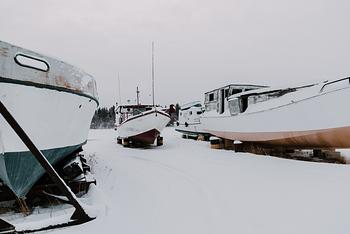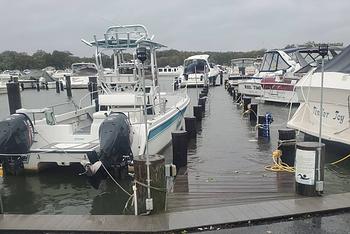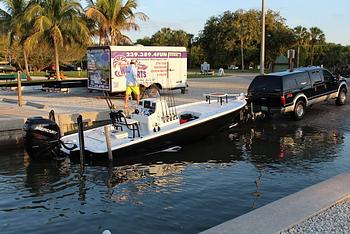Owning a boat requires decisions, not only at the helm but when planning where to keep the boat all year ‘round. One of your top decisions to make is where to store your boat, both during the boating season and during the off-season when you’re away, the weather gets chilly, or in many places, wintry winds, snow and ice blow across the waterfront.
There are many factors to take into consideration when making your choices; the cost of storing a boat, how much access you need to your boat, how far you’ll need to travel to get to your boat, and how safe and secure it is. In this article, we’ll look at all the options you have, both during the height of the season when you want to use your boat regularly, and when it needs safe storage in the off-season (see our guide on how to winterize a boat and a boat motor).

Types of Boat Storage
- Boat storage at home: The cheapest option on our list is to keep your boat on your own property. Whether that’s indoors in a garage or purpose-built shed, or outdoors on a driveway protected by a tarp or cover, it allows you to trailer your boat to the launch ramp of your choice. The next step up from this is to consider trailering your boat to field storage, where a small fee will be charged.
- Dry-stack storage: Generally for smaller-sized boats, dry stacks are facilities that see your boat literally stacked on giant shelves in a storage facility. It will have full protection from the elements as well as protection from security cameras. In many locations, this is an off-season-only option, but in some locations you’ll find marinas with dry-stack storage and one downside is that you don’t have access to it for any maintenance until the boating season begins. Some marinas offer in-season concierge service to launch and haul your boat each time you need it, which increases the cost.
- Outdoor self-storage: This is one of the most affordable options and involves your boat being stored outdoors at a facility but kept out of the water. While it offers some protection from ice and water damage, it will be more at the mercy of the weather if you have a winter season. Your boat may be readily accessible, of course, for maintenance and cleaning.
- In-water storage in a marina: Marinas typically offer excellent facilities, but they come at a price. Marina boat storage using in-water slips will give you plenty of peace of mind with regards to safety, as well access to your boat and the water through the season. However in-water storage isn’t always the preferred choice for smaller boats, and it may not be an option in regions where water is likely to freeze.
Off-Season Boat Storage
How and where you store a boat in the off-season will depend mostly on your prevailing climate. In temperate regions, it’s common to store your boat in the water year round as winters are mild and waters don’t freeze. Of course, if you’re not using it for periods, it’s vital that you winterize your boat’s engine properly to protect it against the ravages of saltwater (see our guide to saltwater versus freshwater boats). In regions where waters are likely to freeze around your boat, it’s still possible to rent a winter slip and keep your boat in the water if you add an agitator or ‘ice-eater,” which prevents ice build-up around your boat’s hull.
Trailer and home storage
The easiest and cheapest option is likely to load your boat onto a trailer and store it at home. It’s of course best to keep it covered during the winter season, and ideally you would store it in a garage or shed. Your main concerns are to keep it safe from the effects of frost and ice, as well as theft or vandalism. If you have the space to do it, the advantages typically outweigh the disadvantages;
Pros
- You can ensure it is safe from theft or damage
- You have easy access to it for repairs or maintenance
- You don’t have to rent a space for it
Cons:
- If you need to hire a boat-hauler, you’ll have a round-trip cost.
- Covering your boat will require a cover or shrink-wrapping, at an additional cost.
- Sometimes neighbors and/or homeowners associations don’t allow a boat kept in front of your property

In-water boat storage in a slip
Keeping your boat in a slip through the off-season is something thousands of boaters do every year, but it comes with added considerations. Storing a boat in the water throughout the winter ultimately depends on where you live. In really cold climates, where freezing can occur, damage is not unusual. It is far more common in milder climates.
Pros:
- You’ll have access to electric hook-up, water supply and, in bigger marinas, fuel pumps and other facilities such as chandleries do to repairs and maintenance throughout winter
- There is likely to be good security measures such as security guards, CCTV, and/or perimeter security in place
- It doesn’t take up space on your driveway or garage
- For a wooden boat, it may be the best option as the hull is not subject to repeated swelling and shrinking from immersion and drying out.
Cons:
- You’ll need an agitator to ensure ice doesn’t build up around your boat
- Your boat will need covering and thoroughly winterizing
- It may be a more expensive option
- You’ll need to find a winter storage solution
Dry-stack storage
As we’ve seen above, this is a good winter option for smaller boats, especially in really cold climates.
Pros:
- It offers full protection from the elements
- It is safe and secure
- Costs may be modest.
Cons:
- You can’t have access to your boat to do any maintenance
Outdoor Marina or Self-Storage
These options vary in availability depending on your region. Marinas and boatyards in wintry areas offer outdoor storage within the confines of their yard, allowing them to assist with off-season maintenance. You may also find a more convenient location to keep your vessel outdoors in a boat storage facility that isn’t a marina.
Pros:
- You can find a facility that is close to your home
- For smaller boats, they can be more cost effective than stacked or dry storage
- A great option for those with larger boats or without driveway or garage space.
- This is especially good for larger boats that would otherwise pay high fees to remain in a slip
Cons:
- Security levels vary depending on the facility
- Your boat will need covering but is otherwise open to the elements
- You don’t have easy access to it for maintenance
- Occasionally mice, raccoons or other rodents can make homes inside your boat during the winter months
Covered Self-Storage
Another option for self-storage is to pay a bit more and have your boat under some sort of shelter or cover. While not necessarily in a fully enclosed warehouse, the shelter offers another level of protection.
Pros:
- More protection than simply a tarp or cover
- Good security and surveillance
- Very cost effective compared to indoor self-storage
- Good for larger boats that can’t be dry stacked
Cons:
- Your boat is still open to some of the elements including frost, ice, and rodents

Indoor Self-Storage
Our last option is to store your boat in a fully indoor facility such as a large warehouse.
Pros:
- You can access your boat whenever the facility is open, and you don’t need to have the boat removed from a dry stack
- Security is excellent in these facilities compared to some outdoor options
- Some facilities offer climate controlled environments to fully protect your boat
Cons:
- Boats take up significant floor space for the amount of boats that can be fit in (as opposed to dry stacked) so are more expensive than other options
- Space can be limited, so it can be more difficult to get a spot, especially for larger boats
In-Season Boat Storage
Boat storage options are going to be different in-season and off-season, with regular, easy access required in-season, while the off-season demands protection from the elements. During the boating season, when you want to be out on the water as much as possible, you’ll want easy and quick access to your boat, but also the peace of mind that it’s safe from theft or vandalism.

Trailering and outdoor boat storage at home
We’ve looked at the pros of home storage above, as it’s a good option whether you’re storing your boat throughout the winter months or during the boating season. When the season is in full swing and you want to be out on your boat every weekend, keeping it at home allows you the chance to keep it on the trailer, largely uncovered, and ready to go.
Pros:
- Easy, quick access. Hitch up and head off to your nearest lake or coast
- It’s easy to give it a good wash down after each use or do any maintenance that might arise
- It’s free except for trailer maintenance and gas for your vehicle.
Cons:
- You may need to ensure that your property is well secured and that the boat and trailer can’t be easily stolen. A locked garage is ideal, otherwise lockable gates will also be a deterrent
- In the height of the season, you might have waiting times or need a reservation to launch at your local ramp.
Mooring a boat in season
Two kinds of moorings are available for boats depending on your region: slips at a local marina or mooring buoys in harbors that have them available. Either type allows you to keep your boat ready and waiting to set off for adventures on the water. Costs will vary widely depending on the size of the marina, the facilities it offers, the location and demand for slips and mooring buoys, and how big your boat is and much water it needs under its keel. When it comes to docking your boat at a marina, you have the option of a slip with easy access, while the mooring buoy slightly offshore requires a launch or tender ride to get aboard.
Pros
- Your boat is already in the water ready to be used whenever you want it
- A marina will likely offer extra services such as electricity, water, WiFi, and equipment storage
- Boats on a mooring buoy can come alongside the marina dock to load equipment or water.
- In a marina, there is likely to be CCTV protecting your boat
- There is a good camaraderie with fellow boat owners
Cons
- In-water marina fees can be expensive (less so for mooring buoys)
- You have to travel to your boat to do maintenance
- Protection against bad weather varies depending on the type of docks; mooring buoys are often easier on boats if they are well-secured.
- You are limited to cruising in the same region all season
- You will need a launch or tender to get you to your boat on a mooring buoy.
Dry outdoor boat storage
Somewhere in between storing your boat at home and storing it in a slip is dry storage in a marina or another secured field or facility that offers boat storage. Essentially this involves trailering your boat and removing it from the water, but leaving it in a secure, covered, outdoor place.
Pros:
- More cost-effective than having a slip
- You don’t have to trailer your boat all the way home
- You can take your boat anywhere you wish to launch it, giving you different cruising ground
Cons:
- Not all dry storage facilities are created equal, so be sure to check what security they offer
- Ask about their operating times as they might lock the gates at a certain time, meaning you have to be back from your day out in time to get your boat back in before closing
Dry boat storage indoors
This is a less common option for boat storage during the boating season, as most indoor storage for boats, as we’ve seen, use racks which store boats long-term. Of course, having your boat put on a rack means you can’t access it easily to use, and so indoor dry storage would need to be on ground level and have easy access for boaters. While it is possible to find this, it only tends to be common in high-density boating areas and can be expensive.




